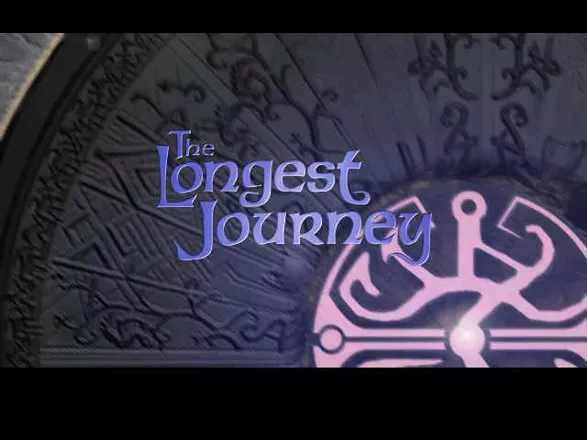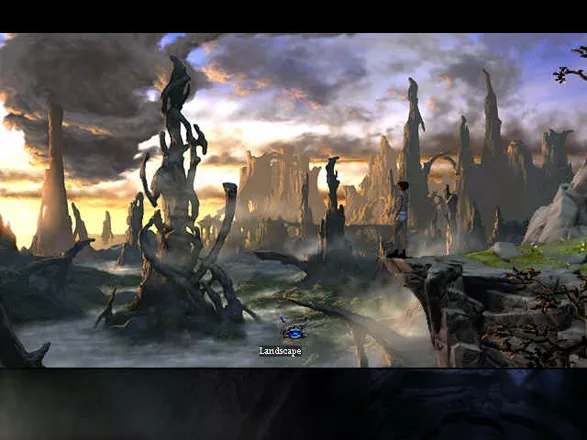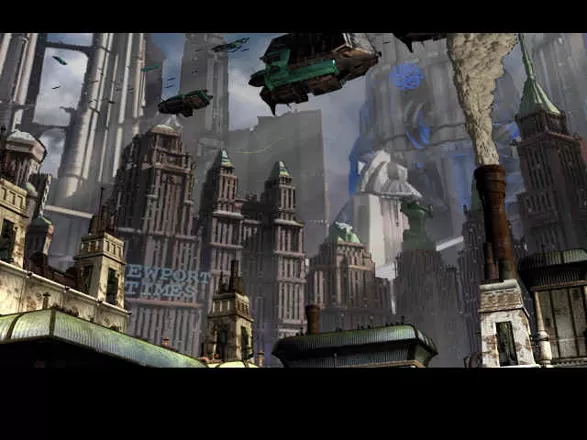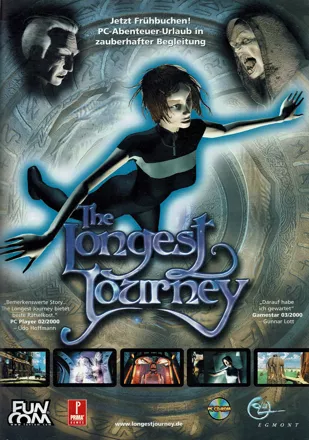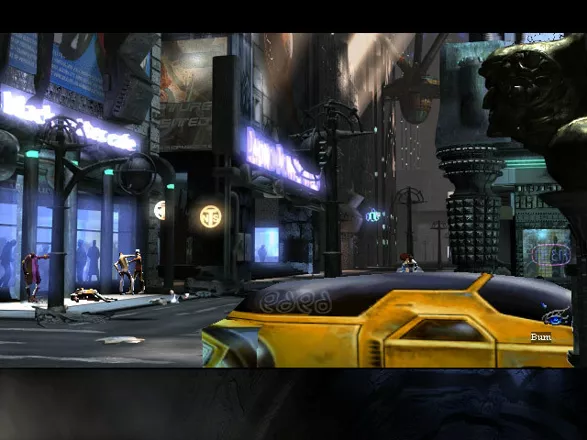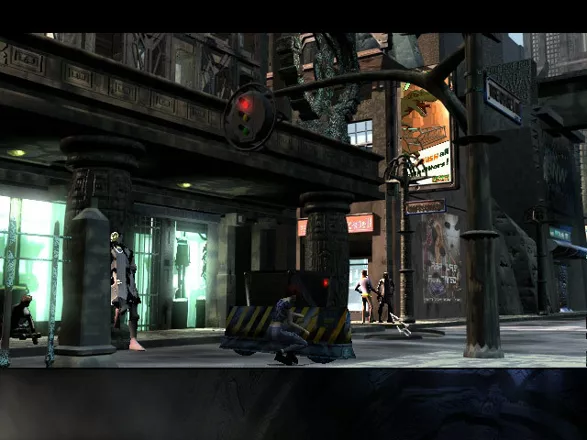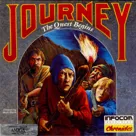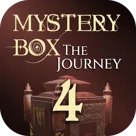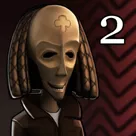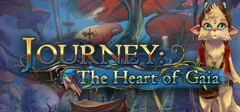The Longest Journey
Description official descriptions
April Ryan is a struggling student artist in the year 2209, recently arrived in the big city of Newport. Lately she has been seeing strange, life-like dreams. Somewhere in the mountains, a mysterious white dragon talks to April, calling her the "mother of the future". When April wakes up, she dismisses the vision as a nightmare. However, an old enigmatic man named Cortez, whom April has spotted near her house before, unexpectedly tells her that she must face the reality in her dreams. Soon April learns that our reality is but one facet of a universe that consists of two parallel worlds: Stark, the world of science and technology, and Arcadia, the world of magic. Though raised in Stark, April possesses the ability of shifting between the two worlds, and must restore the balance in both of them before it is too late.
The Longest Journey is a third-person puzzle-solving adventure game. The player navigates April over pre-rendered backgrounds with fixed camera angles, interacting with people and objects through a simple point-and-click interface. The gameplay follows the traditional template introduced in LucasArts adventures, relying mostly on inventory-based puzzles and multiple-choice dialogues to advance the story. To help keep track of things, the game includes a diary, where April records her thoughts about important events, and a conversation log that records the text of every conversation.
Spellings
- Бесконечное Путешествие - Russian spelling
- 無盡的旅程 - Traditional Chinese spelling
Groups +
Screenshots
Promos
Credits (Windows version)
199 People (193 developers, 6 thanks) · View all
| Producer | |
| Lead Designers | |
| Written By | |
| Art Director | |
| Lead Programmer | |
| Programmers | |
| Installer and Launcher | |
| 3D Studio Max Plug-Ins | |
| Translation Tool | |
| Randy | |
| [ full credits ] | |
Reviews
Critics
Average score: 88% (based on 52 ratings)
Players
Average score: 4.2 out of 5 (based on 213 ratings with 17 reviews)
Great adventure until it reaches the end.
The Good
| Prelude |
Like any other adventure fan, I rushed to get this game after I saw it's potential for releasing interesting vibes and graphical pleasure... although took me a few years longer than I expected. After a full installation of 2+ gigabytes of space and no need for CD-ROM drive, I ran this game to great amazement, I wonder what my face looked like when I saw what I was missing for so long by constantly postponing its getting. It started promising, very promising and very cunning in its own veil of mystery, but it didn't take me too long to realise just how they managed to make a simple wanna-be-epic story out of this game and thus turning the screws into the opposite direction of 'good.'
| And a big + goes to... |
**The Bad**
| And a li'l - goes to... |
**The Bottom Line**
An adventure game that makes a splendid presentation of how you can make a wrong turn even when you're equipped with all the means to create a masterpiece or a classic.
Windows · by MAT (240968) · 2012
The Good
Likeable main character, nice art and backgrounds, plenty of interesting dialogue and immersive gameplay.
The puzzles border on the simplicistic but are consistent with the setting and don't feel forced.
The plot is nothing new but moves along smoothly despite being unoriginal.
Streamlined and unobtrusive interface that rarely gets in the way.
Great Introduction and first part, with very high production values.
The Bad
3D characters lack polygons and don't look very great against the 2D backgrounds, especially in close-ups and cutscenes (that are few, blocky and poorly done).
Some of the characters share the same voice actor (that does a poor job of trying to alter his voice) and some sections seem rushed (especially towards the end) with too few locations/things to do.
The final part and ending seem hastily done (like the publishers wanted to get the game out of the door asap).
The Bottom Line
A great addition to the adventure games genre and a very engrossing experience.
Windows · by Paolo Cumin (11) · 2005
The Good
When Longest Journey appeared on the stage, it generated a small sensation among adventure fans. Made by a Norwegian developer hitherto focused on console games, it was quickly proclaimed a modern masterpiece, and was frequently mentioned in speeches as argumentation against those who have condemned the genre to death. So, is it really that good? And, more importantly, can it save the adventure genre?
My opinion is that it is a nice game, but certainly not one that can compete with the classic offerings of Legend, Sierra, or LucasArts.
The game is firmly rooted in the existing traditions of adventure-making, most notably echoing the tendency of merging old-school inventory-based gameplay with serious settings and strong, emotionally charged plots rich in lore and characters. As everyone know, Gabriel Knight truly started that trend, and is rightly regarded as a milestone for that. Longest Journey was clearly influenced by that game, as well as perhaps the more recent Grim Fandango, which it resembles in overall structure and aspirations.
The journey is indeed long. The game has a linear story with rather frequent changes of locations; but each area is appropriately large, usually consisting of at least several interconnected screens you can explore. Longest Journey takes you to many interesting places, and it keeps up a good pacing, neither precipitating events and rushing towards the end, nor sticking too much to the same location. The game world is generously designed: there is a variety of indoor and outdoor locations, and most of them are interesting to visit. There are a dozen or so chapters, each focusing on a particular event or task needed to fulfill in either of the two worlds the game is set in. The considerable length of the plot reflects the game's premise of an epic adventure.
Perhaps the most appealing aspect of the game is the new world it creates. The central idea of the story - the conflict between science and magic - may not be very original, but it is executed with love and attention to detail. The concept of allowing a normal, ordinary girl to catch a glimpse of a world she had no idea about, making her gradually unravel the truth about it and herself, works here just like it should. Like April Ryan, you discover a new world, surprised by everything you see. The larger part of the game is set in that "other" world, and the feeling of magical, wondrous exploration of the unknown is captured very well.
The developers weren't stingy with material: the game contains loads of information about the world, its history, its characters and concepts, and so on. It's true that the dialogues can get too dry and overly informative; but it is admirable that the designers wanted to cram as much lore as they could into them. In that way, Longest Journey is similar to role-playing games: its star is the universe itself rather than its characters or even concrete events constituting the game's story.
Longest Journey is a beautiful game. Most backgrounds are exquisitely detailed and ooze atmosphere. The Norse love of vast, majestic landscapes serving as potential battlegrounds for an upcoming confrontation between forces beyond our imagination is strongly manifested in this game. It is interesting to note that, although the nature in the game can hardly be called lush or exotic, some of the backgrounds convey an almost mystical, appropriately otherworldy feeling, mesmerizing in their somewhat cold beauty, reminding of pure and transcendental things lost to the futuristic world of soulless skyscrapers and high-speed transportation.
The Bad
The gameplay of Longest Journey is archaic. What's worse, it doesn't really fit the game's ambiance and story. Most puzzles are taken directly from classic comedy adventures of the past (most notably LucasArts' works) and are out of place in this seriously-minded and only mildly and very sporadically humorous game. Predominantly unrealistic and artificial, the game's puzzles involve sterile and awkward inventory item manipulations. They may not be as offensive as their infamous contemporary cat mustache, but they aren't as amusing as that one, either. Besides, this game doesn't have investigations, computer research, or other challenging activities besides inventory combinations and a few isolated logic puzzles.
Some of the inappropriately nonsensical, contrived tasks are at odds not only with the tone of the game, but also with the situations it puts the player in. For example, infiltrating a police station by means of a ridiculously labored concoction ruins the tension of the moment and the seriousness of the event. The game also has a few scenes where the heroine is in mortal danger; yet the ubiquitous "no death" policy turns them into unbecomingly serene affairs. Contrary to popular opinion, I don't think that LucasArtian device was the ultimate cure to the problems of adventure games. I believe that Sierra was on the right track creating potentially dangerous situations for the player instead of holding his hand all the time. This game, in particular, would have benefited from that design philosophy.
Much of the time here is spent on conversations with other characters. Unfortunately, they tend to drag quite a bit. Serving mostly as containers of background information necessary to understand the game's complex story, these dialogues can get very long-winded, often slowing down the game's tempo to a crawl. There are no close-ups on character faces during conversations, so you'll have to just read and occasionally click on a line to trigger the next batch, without having the feeling of really participating. The writing is good, but lacks personality and that extra treatment that made the classics of the past so inimitable.
The Bottom Line
Longest Journey is neither the savior of adventures, nor the innovative, groundbreaking game it so wanted to be. In fact, as an adventure game, it's just above average, falling short of the past greatness it passionately strives to imitate. It can't resurrect the ailing genre, though it does make its agony less painful.
Windows · by Unicorn Lynx (181775) · 2016
Discussion
| Subject | By | Date |
|---|---|---|
| remake? | hvrsd hvrsd (1) | Jul 11, 2007 |
Trivia
1001 Video Games
The Longest Journey appears in the book 1001 Video Games You Must Play Before You Die by General Editor Tony Mott.
April Ryan
The publisher of The Longest Journey, Egmont Interactive, actually tried to turn April Ryan into a pop icon to match Lara Croft. To that end, they cast a real-life model for April -- 23 years old psychology student Katja Koopmann of Bremen, Germany -- and toured the major magazine and newspaper offices with her, dressed up like April and sputtering lines like “I find April sympathetic” with a somewhat forced smile. Once the PR machine runs, even mediocre game sales can’t stop it. On her way to media star, the virtual April next recorded a song -- a dance remix of the 80’s Depeche Mode tune The Balance -- and Katja lend her voice. Egmont spiced April’s image up with exceptionally stupid PR blurb like “I want everything! Above all, I want to show the people of your world something of the life here!” Generally ignored by the public, the song entered the stores on April 14th ‘00, and stayed there. The corresponding video clip was never played on the music channels, the song didn’t appear in the radio shows, and nobody bought the CD.
Dreamweb
The main character's name is April Ryan, just like Ryan in the game Dreamweb, also published by Empire Interactive Entertainment. And the plots of both games have some things in common (the hero who suffers from nightmares and must save a world he/she didn't even know existed in the first place).
References
- A reference to the Monkey Island series: April's pet toy is called Constable Guybrush. And yes, it's a monkey.
- There are lots of references to sci-fi movies and fantasy themes. Most prominent are the references to Brazil, for instance, which takes place on a red tape-clogged insensitive world much like stark. Take a look at the lobby of the Church of Voltec, it's an exact replica of the Information Retrieval building on Brazil. Also the whole repairmen puzzle where they refuse to work on the grounds that it would require a specific form for them to do so is a spoof of the "Central Services" sequence in the movie. They are even dressed in the same way! There are many more, some more subtle than others.
- Want Star Wars references? check out that strange metal ball on the entrance to The Fringe Café. It says "Death Star" click on it and April will spout famous lines related to it, like "Let's blow this thing and go home!" and she even tries to imitate the voices!
Sales
The Longest Journey was originally made only to be released in Scandinavia, but it then grew with the sales to cover Europe and the U.S. By June of 2001, The Longest Journey had sold 250,000 copies worldwide, 90,000 of which were in America.
Version differences
In order to preserve his foreigner condition, Cortez had his nationality changed from Spanish to French and was renamed "Corthez" in the Spanish version.
Voice acting
- The character Marcus, who only appears in the first chapter near the Fringe cafè, and only has two lines, was voiced by Ragnar Tørnquist, the director/lead designer of the game for the English release.
- In the German pre-release demo version, April was voiced by German pop singer T-Seven known from the, at the time, successful Eurodance group Mr. President. In the final game, April was voiced by Stephanie Kindermann.
Awards
- Computer Gaming World
- April 2000 (Issue #201) - Adventure Game of the Year
- Gamespy
- 2000 - Adventure Game of the Year
- PC Gamer
- 2000 - Adventure Game of the Year
Information also contributed by -Chris, Agent 5, jeremy strope, Karthik KANE, kelmer, Stargazer and Zovni
Analytics
Upgrade to MobyPro to view research rankings!
Related Sites +
-
Hints for The Longest Journey
Adventurers will appreciate these hints. They let you solve the game yourself without spoiling it for you. -
Interview with Ragnar Tornquist
Randy Sluganski talks with Mr. Tornquist about The Longest Journey and its upcoming sequel. -
TLJwiki
A wiki covering the The Longest Journey series. -
The Divide .org - Powered by The Longest Journey Fans
Fansite dedicated to The Longest Journey, an awesome PC adventure game produced by Funcom. Features fan fictions, fan arts, wallpapers, downloads, news, polls, and discussion board. -
Zarf's Review
A review of The Longest Journey by Andrew Plotkin (December, 2002).
Identifiers +
Contribute
Are you familiar with this game? Help document and preserve this entry in video game history! If your contribution is approved, you will earn points and be credited as a contributor.
Contributors to this Entry
Game added by andyhat.
iPhone, iPad added by MrMamen.
Additional contributors: n-n, Robin Lionheart, curacao, Jeanne, JRK, Dec Ryan, Kabushi, Stratege, Zeppin, Laverne, Paulus18950, Patrick Bregger, MrMamen, FatherJack.
Game added May 14, 2000. Last modified April 22, 2024.




